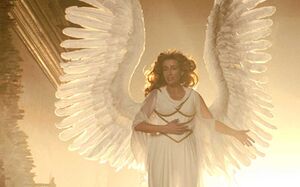Angels in America: Difference between revisions
| Line 146: | Line 146: | ||
==Additional Resources== | ==Additional Resources== | ||
[http://www.januarymagazine.com/artcult/angelsinam.html Larger Than Life] - A review of'' Angels in America'' by Tony Buchsbaum. | |||
==Works Cited== | ==Works Cited== | ||
Revision as of 20:43, 18 April 2006
Factual Information
Study Guide
Part One: Millennium Approaches
Act One: Bad News
- Act One, Scene 1
- Act One, Scene 2
- Act One, Scene 3
- Act One, Scene 4
- Act One, Scene 5
- Act One, Scene 6
- Act One, Scene 7
- Act One, Scene 8
- Act One, Scene 9
Act Two: In Vitro
- Act Two, Scene 1
- Act Two, Scene 2
- Act Two, Scene 3
- Act Two, Scene 4
- Act Two, Scene 5
- Act Two, Scene 6
- Act Two, Scene 7
- Act Two, Scene 8
- Act Two, Scene 9
- Act Two, Scene 10
Act Three: Not-Yet-Conscious, Foward Dawning
- Act Three, Scene 1
- Act Three, Scene 2
- Act Three, Scene 3
- Act Three, Scene 4
- Act Three, Scene 5
- Act Three, Scene 6
- Act Three, Scene 7
Part Two: Perestroika
Act One: Spooj
- Act One, Scene 1
- Act One, Scene 2
- Act One, Scene 3
- Act One, Scene 4
- Act One, Scene 5
- Act One, Scene 6
Act Two: The Epistle
Act Three: Borborygmi
Act Four: John Brown's Body
- Act Four, Scene 1
- Act Four, Scene 2
- Act Four, Scene 3
- Act Four, Scene 4
- Act Four, Scene 5
- Act Four, Scene 6
- Act Four, Scene 7
- Act Four, Scene 8
- Act Four, Scene 9
Act Five: Heaven, I'm in Heaven
- Act Five, Scene 1
- Act Five, Scene 2
- Act Five, Scene 3
- Act Five, Scene 4
- Act Five, Scene 5
- Act Five, Scene 6
- Act Five, Scene 7
- Act Five, Scene 8
- Act Five, Scene 9
- Act Five, Scene 10
Epilogue: Bethesda
Characters
Major Themes
Major Symbols
Influences
Study Questions
- Many of the gay characters struggle with the question of how their sexuality should be, and several come out in different ways during the course of the play. Discuss the meaning of the closet — are closeted characters different from uncloseted ones? What implications does coming out have for self and community?
- "It's law not justice," Joe tells Louis during their final breakup. Discuss the themes of law and justice as they appear in the play. Is Joe correct that the two are separate entities? Or does the play encourage a more visionary potential of the law?
- Belize stands out as exceptionally compassionate and good, yet at times seems two-dimensional. Which view is correct? Is Belize a virtuous stereotype or a complex moral authority?
- What does the subtitle "A Gay Fantasia on National Themes" suggest? What national themes are evident in the plays? What is the relationship between "gay" and "national"?
- Perestroika was the term for Mikhail Gorbachev's policy of political and economic reform in the Soviet Union. In what ways does the play represent the possibility of perestroika in America? Is this an appropriate title for part two?
- Choosing at least two examples (The Rosenberg Trial, The San Francisco Earthquake, Chernobyl, The Reagan Administration), analyze the role of history in the plays. Does Kushner more or less depict events as they happened? If not, what dramatic and thematic purposes does he serve by shading the facts?
- As a "fantasia," Angels in America is a major departure from prevailing theatrical realism, with detours into the religious and the supernatural — angels, ghosts, apparitions, and visions appear over and over. What effect do these fantastical elements have on the play as a whole? Go beyond a simple analysis of plot to consider the implications for characters, messages, and themes.
Additional Resources
Larger Than Life - A review of Angels in America by Tony Buchsbaum.
Works Cited
- Garner, Stanton B. "Angels in America: The Millennium and Postmodern Memory," in Approaching the Millenium, Essays on Angels in America, edited by Deborah R. Geis and Steven F. Kruger, University of Michigan Press, 1987: pp.173-84.
- Glenn, Lane A.. "Angels in America." Drama for Students. Gale, 1999.
- Kruger, Steven F. "Identity and Conversion in Angels in America."in Approaching the Millennium: Essays on "Angels in America." edited by Deborah R. Geis and Steven F.Kruger, University of Michigan Press, 1997: pp. 151-69.
- Layman, Bruccoli Clark. "Tony Kushner,"in Dictionary of Literary Biography, Volume 228: Twentienth Century American Dramatists, Second Series. Edited by Christopher J. Wheatley.
- McNutty, Charles. "Angels in America: Tony Kushner's Theses on the Philosophy of History." Modern Drama 39,no.1 (Spring 1996): 84-96.
- Meisner, Natalie. Messing with the Idyllic: The Performance of Femininity in Kushner's Angels in America. The Yale Journal of Criticism 16,no.1 (2003): 177-189.
- Quinn, John R. "Corpus Juris Tertium: Redemptive Jurisprudence in Angels in America." Theatre Journal 48,no.1 (March 1996): 79-90.
- Trilling, Lionel, et. al. Bloom’s Period Studies: Modern American Drama. Chelsea House Publishers, 2005.
- Kushner, Tony. Angels in America. New York: Theatre Communications Group, 1995.

